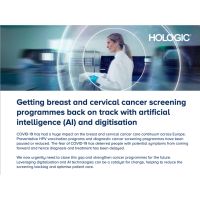Breast cancer screening remains controversial, despite strong evidence of its benefits, including a recent study showing a 47% reduction in risk of death among Swedish women who participated in screening compared with those who did not. In addition, U.S. National Cancer Institute (NCI) data demonstrate that breast cancer mortality has fallen 43% since regular mammography screening began in the 1980s.
However, sceptics argue that screening is causing more harm than benefit to women. The harms cited include false positives leading to additional testing, with the accompanying emotional and financial burdens, and potential overtreatment of low-grade malignancies that, if left undiagnosed and untreated, would not cause death.
One might expect that support for screening would improve with the increasing availability of digital breast tomosynthesis (DBT), given the data demonstrating its diagnostic performance. DBT, particularly when applied as it is most commonly used (i.e., 3D plus 2D digital mammography), increases cancer detection rates, as compared to those of the conventional digital mammography (DM). The results are mixed with regard to effect on recall rates, with most studies showing a greater reduction with DBT compared with DM.
The objective of screening is to save lives. Yet questions remain as to whether DBT is better than DM at detecting the most aggressive and deadly breast cancers before they can advance to the point where they become a danger to the life of women.
Randomised trial: first of its kind
Dr. Etta D. Pisano, of Beth Israel Deaconess Medical Center in Boston, who is a member of the American College of Radiology, says the Tomosynthesis Mammographic Imaging Screening Trial (TMIST) should help address these important issues regarding screening. The trial is funded by the NCI and managed through the Eastern Cooperative Oncology Group and the American College of Radiology Imaging Network (ECOG-ACRIN) Cancer Research Group.
TMIST, the first randomised trial to compare DBT with DM for breast cancer screening, is currently enrolling healthy women, ages 45 to 74 years, who are already planning to get screening mammograms. In this study, some 165,000 women will be randomly assigned to 3 to 5 rounds of screening with either DBT or DM. Study sites are collecting data not only on the interpretations of the screening mammograms and the mammograms themselves but also on follow-up tests and any adjuvant screening tests that are performed. All participants will be followed for up to 8 years after entry for breast cancer detection, stage and grade, treatment, and other relevant health events, including mortality.
Through this large cohort in TMIST, according to Dr. Pisano, we are likely to develop a better understanding of which subpopulations benefit from DBT and which can be equally well-served by DM, which is not only less expensive but also often requires less radiation for the woman and less time for image interpretation. The primary endpoint of TMIST is to compare the numbers of “advanced cancers” found in the study’s two arms.
A key element of the TMIST study is the voluntary contribution of blood or buccal smears from study subjects, allowing the creation of a biorepository for future research on genetic markers for breast and other cancers. These data, along with other information collected in TMIST (e.g., demographics, family history, personal history, etc.) will allow us to build better models to individualise breast cancer screening, Dr. Pisano explains.
Source: Journal of Breast Imaging
Image credit: iStock
References:
Pisano ED (2019) Tomosynthesis for Breast Cancer Screening: The Important Contribution the Tomosynthesis Mammographic Imaging Screening Trial Will Make to Our Knowledge of Breast Cancer Screening. Journal of Breast Imaging, wby018, https://doi.org/10.1093/jbi/wby018
Latest Articles
Tomosynthesis, breast cancer screening, breast imaging, dbt, Breast tomosynthesis, TMIST study
Breast cancer screening remains controversial, despite strong evidence of its benefits, including a recent study showing a 47% reduction in risk of death among Swedish women who participated in screening compared with those who did not. In addition, U.S.






















